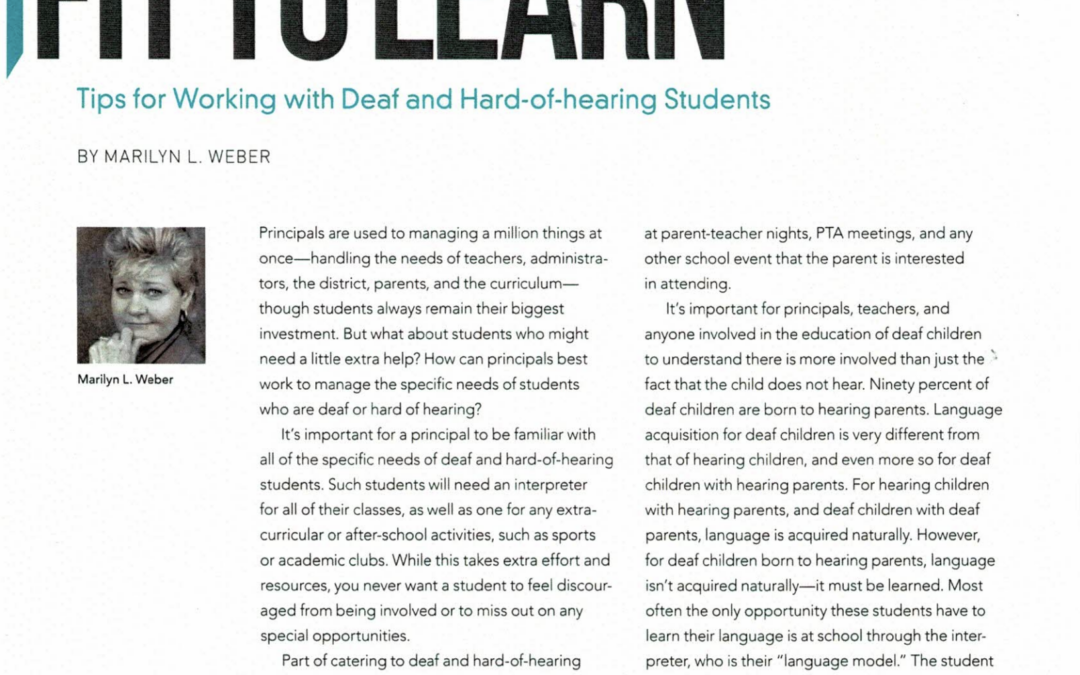By Marilyn L. Weber
Imagine trying to learn a lesson in a classroom trapped inside of a clear sound-proof box. The only way you can gather information is visually and you will be tested on what you’ve learned – or were supposed to have learned – at the end of the day. Seems a bit unfair, doesn’t it?
The only way you can gather information is visually and you will be tested on what you’ve learned – or were supposed to have learned – at the end of the day. Seems a bit unfair, doesn’t it?
This could be anything from the basic ABC’s to complex mathematical equations – deaf and hard-of-hearing students face many challenges in their day-to-day lives. So much so that their challenges in the classroom are all too often over-looked.
With that being the case, here are 10 challenges that deaf and hard-of-hearing students face in the classroom, along with guidelines for teachers on how to mitigate them:
- Classroom Acoustics: Acoustics are often a problem in the classroom, but luckily there are several ways to solve this challenge. Deaf or hard-of-hearing students need full visual access, so the best seating arrangement for full participation, engagement and access by these students is to arrange desks in a “U” shape. This will allow the students to see who is speaking, and participate fully in the conversation.
- Lighting: Fluorescent lights emit a special sound that interferes with hearing aids and cochlear implants, making it even more difficult when trying to distinguish what peers or the teacher are saying. Consider the placement of the window in relation to the teacher, the interpreter and the deaf or hard-of-hearing student. Windows and light should not be behind the interpreter or teacher because this makes it difficult, if not impossible, to see the signs produced by the interpreter or the teacher’s lesson.
- Language Deficiencies: Keep in mind that some deaf students’ first (or second!) language may not be English. Be sure to provide an appropriate interpretation service that will effectively communicate the lesson in their primary language.
- Experiential Shortages: Research shows that deaf students often lag behind their hearing peers when it comes to number concepts, language and problem solving skills. Hearing students constantly absorb new information and knowledge through the daily noises, conversations and language that is spoken around them. Deaf and hard-of-hearing students do not have that luxury. Teachers can bridge this gap by being flexible in the way that they respond to the educational concerns of their deaf students.
- Lip-Reading/Residual Hearing: Teachers often hypothesize that their deaf students are capable of lip-reading – which can be true – but it is essential to keep in mind that only 30-40% of spoken English is distinguishable on the lips. Students who rely on lip-reading often perform better when it is a subject that is familiar. When lecturing students, teachers should consistently face their deaf students, never talk when handing out papers, pause before heading into a new subject and give the deaf student applicable time to process the preceding subject’s information in case he/she has any questions.
- Inadequate Knowledge and Awareness: Every child learns differently. Even if teachers are given instruction on how to best assist one of their deaf students, it could be completely different for the next, resulting in an academic gap.
- Social Concerns:Children who are deaf often tend to feel uncomfortable in the classroom when drawing attention to their hearing problem. They want to be like their friends with ‘normal’ hearing, so this drives them to mainly keep to themselves and prefer to not take part in classroom activities.
- Collaboration:Due to busy schedules during the school year, it is often difficult to hold regular, collaborative meetings with the individuals that are critical components to a deaf student’s academic progress. We recommend that teachers remain in constant, close communication with the student and his or her parents, as well as make sure the interpreter is available to assist with complete understanding. This will ensure that everyone is on the same page and is available for ongoing conversations about proper educational techniques and adequate learning environments for the deaf or hard-of-hearing student.
- Curriculum and Instruction: Some teachers require all students to take lecture notes during class. A suggestion to assist the deaf student with this requirement would be to provide them with a written or digital copy of the lecture information beforehand. If it is preferred that the student engages more actively in class, teachers can provide a printed copy listing key points, so that the majority of the student’s attention remains on the lesson. We also encourage teachers to use interactive whiteboards if available.
- Lack of Resources: Often schools are not capable of supplying their deaf or hard-of-hearing students with the proper technology that could significantly increase the learning development process. This could be any form of assistive technology – interactive whiteboards, VRI, chat rooms, strobe lights, digital pen technology, closed captioning on all movies and videos, infra-red systems – hearing aid compatible, computer assisted note taking, ASL videos for testing materials, alert systems such as vibrating systems, and alarms and interpreters in the classroom.
These are only 10 of the many challenges that deaf and hard-of-hearing students face in the classroom, and we hope it helps open conversations in your school and district about taking a few additional steps to assist deaf students in the classroom. By acknowledging the challenges deaf students are facing and implementing strategies to alleviate those learning barriers, teachers create a learning environment that will benefit all students every day.




